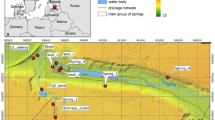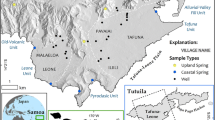Abstract
Humid dunes in the UK are at risk from nutrient pressures from multiple sources. The Water Framework Directive 2000/60/EC (WFD) requires assessment and identification of these pressures with appropriate measures defined to mitigate against further damage. We discuss the application of nitrate threshold values for the WFD classification, illustrating this with a case study at Merthyr Mawr, South Wales, where ephemeral groundwater discharge from a spring (‘Burrows Well’) sourced within the Carboniferous Limestone, creates a large dune slack. Ecological surveys suggest that the vegetation in this slack was in unfavourable condition, due to high levels of nitrate. Applying the source-pathway-receptor model an investigation was undertaken to improve the conceptual model and assess the significance of damage from groundwater derived nutrients. Results show groundwater nitrate concentrations ~ 10 mg/l as NO3-N feeding the main slack waters. The vegetation survey data shows clear evidence of ecological damage, and the hydrogeological data traces the source of this back to the Carboniferous Limestone aquifer and not the overlying blown sands. Discharging groundwater is the source of the enrichment. Isotopic analysis suggests that the N is derived from inorganic fertilizer and/or atmospheric N. During the first cycle WFD characterisation the unfavourable status of the dunes due to chemical groundwater pressure resulted in a failure of the surrounding groundwater body, which was designated as poor status. The site has been re assessed for the 2nd Cycle WFD characterisation where recently developed nitrate ‘threshold’ values have been applied to assess the significance of damage for groundwater derived nutrients. The surrounding Carboniferous Limestone catchment is complex and could not be sufficiently constrained, thus land management changes could not be targeted. The paucity of historical or repeat vegetation surveys limits our ability to measure change within the dune vegetation and causes difficulties in understanding the impact of multiple pressures.







Similar content being viewed by others
References
Bobbink R, Hettelingh JP (eds) (2011) Review and revision of empirical critical loads and dose response relationships. Proceedings of an expert workshop, Noordwijkerhout, 23–25 June 2010. Coordination Centre for Effects, RIVM, NL. www.rivm.nl/cce
Brassington FC, Younger PL (2010) A proposed framework for hydrogeological conceptual modeling. Water Environ J 24:261–273
Brooks A, Brown R, James S (2009) Guidance on monitoring and investigation at groundwater-dependent terrestrial ecosystems (GWDTE). Environment Agency of England & Wales report GEHO1108-BOZG-E-E
Casciotti KL, Sigman DM, Galanter Hastings M, Bohlke JK, Hilkert A (2002) Anal Chem 74:4905–4912
Countryside Council for Wales (2008) Core Management Plan (including conservation objectives) for Kenfig/Cynffig SAC. https://www.naturalresources.wales/media/672610/Kenfig%20SAC%20management%20plan%2021.4.08%20English.pdf
Curreli A, Wallace H, Freeman C, Hollingham M, Stratford C, Johnson H et al (2013) Eco-hydrological requirements of dune slack vegetation and the implications of climate change. Sci Total Environ 443:910–9
Davy AJ, Grootjans AP, Hiscock K, Peterson J (2006) Eco-hydrological guidelines for dune habitats – Phase 1. English Nature Research Reports Number 696
Davy AJ, Hiscock KM, Jones MLM, Low R, Robins NS, Stratford C (2010) Ecohydrological guidelines for wet dune habitats, phase 2. Protecting the plant communities and rare species of dune wetland systems. Ecohydrological guidelines for wet dune habitats. GEHO0310BSGV-E-P. https://www.gov.uk/government/uploads/system/uploads/attachment_data/file/298034/geho0310bsgv-e-e.pdf
Environment Agency (2009) Groundwater quality review: the carboniferous limestone of the Porthcawl – Schwyll aquifer unit. Environment Agency Wales (unpublished)
Environmental Simulations International (2004) The Cornelly Group of Quarries: Hydrogeological impact assessment for Cornelly Quarry and combined quarries. Consultant report for Tarmac Western Ltd
European Commission (2003) Common implementation strategy for the Water Framework Directive, Guidance Document No. 12. The role of wetlands in the Water Framework Directive. ISBN 92-894-6967-6
Farr G, Hall J (2014) Atmospheric deposition at groundwater dependent wetlands: implications for effective catchment management and Water Framework Directive groundwater classification in England and Wales. Nottingham, UK, British Geological Survey, 62 pp. (OR/14/047) (Unpublished) http://nora.nerc.ac.uk/510750/
Farr G, Whiteman M, Jones PS (2014) Ecohydrological methods for the investigation of significant damage at groundwater dependant terrestrial ecosystems. In: IAH Ireland conference Proceedings 2014: The Role of Hydrogeology, Ireland, April 2014. British Geological Survey. http://nora.nerc.ac.uk/507428/
Gooddy D, Darling G, Abesser C, Lapworth DJ (2006) Using chlorofluorocarbons (CFCs) and sulphur hexafluoride (SF6) to characterise groundwater movement and residence time in a lowland Chalk catchment. J Hydrol 330(1–2):44–52. doi:10.1016/j.jhydrol.2006.04.011
JNCC (2004) Common standards monitoring guidance for lowland wetland, Version August 2004, ISSN 1743–8160
Jones MLM, Pilkington MG, Healey M, Norris DA, Brittain SA, Tang YS, Reynolds B (2005) Determining a nitrogen budget for Merthyr Mawr sand dune system. Final report for Countryside Council for Wales. CEH Project No: C02352NEW, CCW Contract No: FC 72-02-59. May 2005
Jones MLM, Reynolds B, Brittain SA, Norris DA, Rhind PM, Jones RE (2006) Complex hydrological controls on wet sand dune slacks: the importance of local variability. Sci Total Environ 372:266–277
Mayer PM, Reynolds SK, Marshall J, McCutchen D, Canfield TJ (2007) Meta-analysis of nitrogen removal in riparian buffers. J Environ Qual 36:1172–1180
Oster H, Sonntag C, Munnich KO (1996) Groundwater age dating with chlorofluorocarbons. Water Resour Res 32(10):2989–3001
Plummer LN, Busenberg E (2000) Chlorofluorocarbons: tools for dating and tracing young groundwater, Environmental Tracers in Subsurface Hydrology (Cook, P., Herczeg, A., Eds), Kluwer Academic Publishers, Boston 441–478.
Rhymes J, Wallace H, Fenner N, Jones L (2014) Evidence for sensitivity of dune wetlands to groundwater nutrients. Sci Total Environ 490(2014):106–113
Rodwell JS (Ed.) (1991–2000) British Plant Communities, vols. 1–5. Cambridge University Press, Cambridge
Schlumberger Water Services (2010) Report on targeted risk-based investigations on selected Welsh Groundwater Dependent terrestrial Ecosystems (Cors Bodeilio and Merthyr Mawr). Report for Environment Agency
Schutten J, Verweij W, Hall A, Scheidleder A (2011) Common implementation strategy for the water framework directive (2000/60/EC). Technical Report No.6 Technical Report on Groundwater Dependent Ecosystems. European Commission Technical Report – 2011–056, December 2011. ISBN 978-92-79-21692-3
Sigman DM, Casciotti KL, Andreani M, Barford C, Galanter M, Bohlke JK (2001) Anal Chem 73:4145–4153
UKTAG (2004) Guidance on the identification and risk assessment of groundwater dependent terrestrial ecosystems. UKTAG guidance paper 5a + b. http://www.wfduk.org/tag guidance/Guidance Papers
UKTAG (2012a) Paper 11b (i) Groundwater Chemical Classification for the purpose of the Water Framework Directive and the Groundwater Directive. Version Feb 2012. http://www.wfduk.org/sites/default/files/Media/Assessing%20the%20status%20of%20the%20water%20environment/GWChemical%20Classification_FINAL_2802121.pdf
UKTAG (2012b) Technical report on groundwater dependent terrestrial ecosystem (GWDTE) threshold values. Version 8 March 2012. http://www.wfduk.org/resources%20/groundwater-dependent-terrestrial-ecosystemthreshold-values
Water Management Consultants (2008) Groundwater dependent wetlands: investigation and instrumentation of six Welsh wetland SSSIs. Consultant report 1–234 for Environment Agency Wales
Wheeler BD, Shaw SC, Hodgson JG (1999) A monitoring methodology for wetlands. Report to Environment Agency, Peterborough
Wheeler BD, Shaw SC, Tanner K (2009) A wetland framework for impact assessment at statutory sites in England and Wales. Environment Agency Science report SC030232/SR1s
Whiteman MI, Wheeler BD, Shaw SC, Lewis T, Grout M, Tanner K (2009) Use of WETMECS typology to aid understanding of groundwater-dependent terrestrial ecosystems in England and Wales. In: Quevauviller, P., Fouillac, A.M., Grath, J., Ward, R. (Eds.), Groundwater Quality Assessment and Monitoring. John Wiley & Sons, pp. 259–272
Whiteman M, Brooks A, Skinner A, Hulme P (2010) Determining significant damage to groundwater dependant terrestrial ecosystems in England and Wales for use in implementation of the water framework directive. Ecol Eng 36:1118–1125
Wilson D, Davies JR, Fletcher C, Smith M (1990) Geology of the South Wales Coalfield, Part vi: the country around Bridgend Memoir of the British Geological Survey, sheet 261 and 262 (England and Wales); 2nd edition; (1st ed. 1904)
Acknowledgments
The authors would like to thank the owners of the site, Merthyr Mawr Estates and the site manager, Duncan Ludlow and Scott Hand (Natural Resources Wales). Paul Inman (Independent Consultant) is thanked for the collection of groundwater level and chemistry data on behalf of Natural Resources Wales. We would also like to thank Tarmac Ltd and Mike Streetly of ESI Ltd for providing discharge data from the Burrows Well. Gareth Farr publishes with the permission of the executive director of the British Geological Survey, NERC. The views expressed in this article are those of the authors and not necessarily those of the Environment Agency, Natural Resources Wales or the Scottish Environment Protection Agency.
Author information
Authors and Affiliations
Corresponding author
Electronic supplementary material
Below is the link to the electronic supplementary material.
Online Resource 1
Borehole log borehole MM1 (PDF 63 kb)
Online Resource 2
Ecological survey data (PDF 3232 kb)
Online Resource 3
Geochemical data for all monitoring points (XLS 5219 kb)
Online Resource 4
Manual groundwater dip data (XLS 1424 kb)
Online Resource 5
Location of hydrological and ecological monitoring points, sea level data, borehole/dipwell hydrographs, Burrows Well flow, rainfall, Burrows Well nitrate(XLS 10026 kb)
Rights and permissions
About this article
Cite this article
Whiteman, M.I., Farr, G., Jones, P.S. et al. Merthyr Mawr: a case study for the assessment of nitrate at humid dunes in England and Wales. J Coast Conserv 21, 669–684 (2017). https://doi.org/10.1007/s11852-016-0485-1
Received:
Revised:
Accepted:
Published:
Issue Date:
DOI: https://doi.org/10.1007/s11852-016-0485-1




